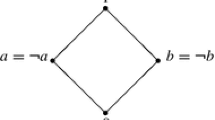Abstract
Stable basis algebras were introduced by Fountain and Gould and developed in a series of articles. They form a class of universal algebras, extending that of independence algebras, and reflecting the way in which free modules over well-behaved domains generalise vector spaces. If a stable basis algebra \(\mathbb{B}\) satisfies the distributivity condition (a condition satisfied by all the previously known examples), it is a reduct of an independence algebra \(\mathbb{A}\) . Our first aim is to give an example of an independence algebra not satisfying the distributivity condition.
Gould showed that if a stable basis algebra \(\mathbb{B}\) with the distributivity condition has finite rank, then so does the independence algebra \(\mathbb{A}\) of which it is a reduct, and that in this case the endomorphism monoid \({\rm End}(\mathbb{B})\) of \(\mathbb{B}\) is a left order in the endomorphism monoid \({\rm End}(\mathbb{A})\) of \(\mathbb{A}\). We complete the picture by determining when \({\rm End}(\mathbb{B})\) is a right, and hence a two-sided, order in \({\rm End}(\mathbb{A})\). In fact (for rank at least 2), this happens precisely when every element of \({\rm End}(\mathbb{A})\) can be written as \({\alpha}^{\sharp} \beta\) where \(\alpha,\beta\in{\rm End}(\mathbb{B})\), \({\alpha}^{\sharp}\) is the inverse of \(\alpha\) in a subgroup of \({\rm End}(\mathbb{A})\) and \(\alpha\) and \(\beta\) have the same kernel. This is equivalent to \({\rm End}(\mathbb{B})\) being a special kind of left order in \({\rm End}(\mathbb{A})\) known as straight.
Similar content being viewed by others
References
Araújo, J.: Idempotent generated endomorphisms of an independence algebra. Semigroup Forum 67, 464–467 (2003)
Araújo, J., Edmundo, M., Givant, S.: \(v^{*} \)-algebras, independence algebras and logic. Internat. J. Algebra Comput. 21, 1237–1257 (2011)
Bergman, G.M.: Constructing division rings as module-theoretic direct limits. Trans. Amer. Math. Soc. 354, 2079–2114 (2002)
Cameron, P.J., Szabó, C.: Independence algebras. J. London Math. Soc. 61, 321–334 (2000)
A. H. Clifford and G. B. Preston, The Algebraic Theory of Semigroups, Mathematical Surveys 7, vols. 1 and 2, American Mathematical Society (1961)
Cohn, P.M.: Free Ideal Rings and Localisation in General Rings. Cambridge University Press, New Mathematical Monographs (2006)
Evans, D.M., Ferreira, M.S.: The geometry of Hrushovski constructions, I: The uncollapsed case. Ann. Pure Appl. Logic 162, 474–488 (2011)
Fountain, J.: Products of idempotent integer matrices. Math. Proc. Cambridge Phil. Soc. 110, 431–441 (1991)
Fountain, J., Gould, V.: Orders in rings without identity. Comm. Algebra 18, 3085–3110 (1990)
Fountain, J., Gould, V.: Relatively free algebras with weak exchange properties. J. Australian Math. Soc. 75, 355–384 (2003)
Fountain, J., Gould, V.: Endomorphisms of relatively free algebras with weak exchange properties. Algebra Universalis 51, 257–285 (2004)
Fountain, J., Gould, V.: Products of idempotent endomorphisms of relatively free algebras with weak exchange properties. Proc. Edinburgh Math. Soc. 50, 343–362 (2007)
Fountain, J., Lewin, A.: Products of idempotent endomorphisms of an independence algebra of finite rank. Proc. Edinburgh Math. Soc. 35, 493–500 (1992)
Fountain, J., Lewin, A.: Products of idempotent endomorphisms of an independence algebra of infinite rank. Math. Proc. Cambridge Phil. Soc. 114, 303–309 (1993)
Fountain, J.B., Petrich, M.: Completely 0-simple semigroups of quotients. J. Algebra 101, 365–402 (1986)
S. R. Givant, A representation theorem for universal classes of algebras in which all members are free, Notices Amer. Math. Soc., 19 (1972) A–767
Gould, V.: Independence algebras. Algebra Universalis 33, 294–318 (1995)
Gould, V.: Abundant and ample straight left orders. Period. Math. Hungar. 46, 171–179 (2003)
V. Gould, Independence algebras, basis algebras and semigroups of quotients, Proc. Edinburgh Math. Soc. (2), 53 (2010), 697–729
Grätzer, G.: Universal Algebra. Van Nostrand, Princeton, NJ (1968)
Gray, R., Ruškuc, N.: On maximal subgroups of free idempotent generated semigroups. Israel J. Math. 189, 147–176 (2012)
Howie, J.M.: The subsemigroup generated by the idempotents of a full transformation semigroup. J. London Math. Soc. 41, 707–716 (1966)
Hrushovski, E.: A new strongly minimal set. Ann. Pure Appl. Logic 62, 147–166 (1993)
Gray, R.: Idempotent rank in endomorphism monoids of finite independence algebras. Proc. Royal Soc. Edinburgh: Section A 137A, 303–331 (2007)
J. M. Howie, Fundamentals of Semigroup Theory, Oxford University Press (Oxford, 1995)
Laffey, T.: Products of idempotent matrices. Linear Multilinear Algebra 14, 309–314 (1983)
M. V. Lawson, The structure theory of abundant semigroups, PhD Thesis, York (1995)
Marczewski, E.: A general scheme of the notions of independence in mathematics. Bull Acad. Polish Sci. 6, 731–736 (1958)
McKenzie, R.N., McNulty, G.F., Taylor, W.T.: Algebra. Lattices, Varieties, Wadsworth (1983)
W. Narkiewicz, Independence in a certain class of abstract algebras, Fund. Math., 50 (1961/62), 333–340
K. S. S. Nambooripad, Structure of regular semigroups. I, Mem. Amer. Math. Soc., 22 (1979), no. 224
Ruitenberg, W.: Products of idempotent matrices over Hermite domains. Semigroup Forum 46, 371–378 (1993)
Urbanik, K.: Linear independence in abstract algebras. Coll. Math. 14, 233–255 (1966)
Zeigler, M.: An exposition of Hrushovski's New Strongly Minimal Set. Ann. Pure Appl. Logic 164, 1507–1519 (2013)
B. Zilber, Strongly minimal countably categorical theories. II, Sib. Math. J., 25 (1984) 71–88
B. Zilber, Strongly minimal countably categorical theories. III, Sib. Math. J., 25 (1984), 63–77
Author information
Authors and Affiliations
Corresponding author
Rights and permissions
About this article
Cite this article
Bentz, W., Gould, V. Independence algebras, basis algebras and the distributivity condition. Acta Math. Hungar. 162, 419–444 (2020). https://doi.org/10.1007/s10474-020-01084-9
Received:
Revised:
Accepted:
Published:
Issue Date:
DOI: https://doi.org/10.1007/s10474-020-01084-9



